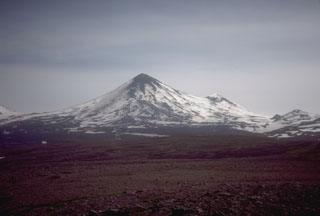Report on Pavlof (United States) — February 1988
Scientific Event Alert Network Bulletin, vol. 13, no. 2 (February 1988)
Managing Editor: Lindsay McClelland.
Pavlof (United States) Weak steam and ash emission
Please cite this report as:
Global Volcanism Program, 1988. Report on Pavlof (United States) (McClelland, L., ed.). Scientific Event Alert Network Bulletin, 13:2. Smithsonian Institution. https://doi.org/10.5479/si.GVP.SEAN198802-312030
Pavlof
United States
55.417°N, 161.894°W; summit elev. 2493 m
All times are local (unless otherwise noted)
During observations that were limited by poor weather December-February, only weak steam and ash emission was reported (table 5).
Table 5. Reports of activity at Pavlof, 9 January-2 March 1988, compiled by John Reeder from the following observers: Theresa Dubber, James Yakal, and Marsha Brown (FAA, Cold Bay); Guy Morgan (Peninsula Airways).
| Date | Time | Activity Reported | Observers |
| 09 Jan 1988 | 1530 | 150-m steam plume with some ash from NE summit vent. | TD |
| 28 Feb 1988 | 0845 | Black plume several hundred meters high from NE summit vent; 15 minutes later, a steam-and-ash plume was rising 600 m and drifting a short distance E. | JY, MB |
| 02 Mar 1988 | 1200 | Gray steam-and-ash plume rising 300-450 m from NE summit vent and drifting E. Only white steam was visible by 1630 and there were no emissions by 1819. The volcano was snow-covered except for snow-free areas around the summit and NE vents. | GM, MB |
Geological Summary. The most active volcano of the Aleutian arc, Pavlof is a Holocene stratovolcano that was constructed along a line of vents extending NE from the Emmons Lake caldera. Pavlof and Pavlof Sister to the NE form a dramatic pair of symmetrical, glacier-covered stratovolcanoes that overlook Pavlof and Volcano bays. Little Pavlof is a smaller cone on the SW flank of Pavlof volcano, near the rim of Emmons Lake caldera. Unlike Pavlof Sister, eruptions have frequently been reported from Pavlof, typically Strombolian to Vulcanian explosive eruptions from the summit vents and occasional lava flows. The active vents lie near the summit on the north and east sides. The largest recorded eruption took place in 1911, at the end of a 5-year-long eruptive episode, when a fissure opened on the N flank, ejecting large blocks and issuing lava flows.
Information Contacts: J. Reeder, ADGGS.

